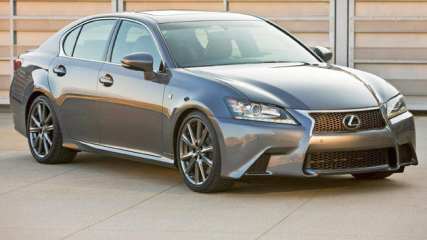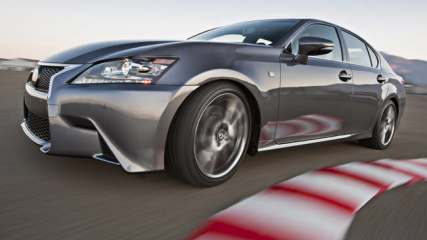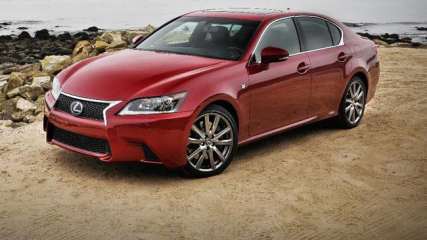Lexus GS 350 2012 review
By Paul Pottinger · 04 Apr 2012
If any single model has embodied the disparity between executive sedans from Europe and those from Japan, it’s been the GS.Even in the most sedate versions, the mid-size wares of BMW, Mercedes-Benz and even Audi have at least a hint of sport saloon about them. By polar contrast, the well-intentioned Lexus GS has been as croquet is to base jumping.The fourth generation, however, comes with the suggestion of no one less than our own Paul Gover - who tossed one about in preproduction form last year - of being something more than a floaty, flatulent, rear-wheel-drive Toyota.As ever, Lexus takes a katana to the Germans, deftly undercutting them on substantial, if not perceived, value. For in prestige cars, perception is - if not all - then at least the half the market, and for this lot the L badge can't equate to those from Europe.If you are one such, then you're reading the wrong auto publication. And if you want to pay two grand for metallic paint - as per the Euro norm - you need more help than I can give you.The GS 250, which we hadn't got into by publication time, starts from $77,900 topping out at $99,900. The 1-litre bigger engined 350 starts with the Luxury ($89,900). In several respects the $10k dearer F-Sport is the one we'd have, with its tail taming rear wheel steer on top of an adjustable chassis.Luxury Sport looks and feels every bit of its $109,900, banks of soft leather rising over the top of the dashboard, a multi media screen bigger than some hotel windows and still priced against the competition in such a way as to be a bargain.Interior fittings, most of them standard from the entry level or included in $3k enhancement packs, read like a luxury lifestyle catalogue. A mouse controlled system in place of the more usual touchscreen, linked to a split-view 12.3inch widescreen dashboard display. Other stuff runs to surround sound, front 20-way power seats; pre-collision system, heads-up display, blind spot monitor, lane keep assist, and Driver Monitoring System.An entirely new body and platform house a typically Lexus-esque array of tech, it's just that you get them for about $20k under anything speaking with a Stuttgart accent. Each GS them get three driving modes, Eco, normal and sport, each distinct and worthwhile in their own right.To this F-Sport adds Sport plus, which to some slight extent reduces the interventionist tendencies of Lexus's formidable battery of electronic safety measures.The dynamic highlight of a model lineup that had been the luxury car equivalent of a milky cup of tea followed by a nice lie down, is the F-Sport's rear steer. Rather more sophisticated than the four-wheel-steering systems of yore, the system turns the rear wheels opposite to the direction of the front at an angle of up to two degrees at speeds of up 80km/h.Shoved fast through a slalom course demonstration, it provides a kick in the rear completely at odds with the comfy cruising image previously synonymous with the bigger Lexus models.But the naturally aspirated 3.5-litre V6 – though enduringly effective in most circumstances – feels like last week's newspapers next to the hugely effective turbo fours being slung by the Germans, let alone the boosted sixes of the 535i and Audi's supercharged S4.The real engine story, you feel, comes in six weeks with the arrival of the GS Hybrid. So I guess we'll be doing this all over again then.This is a tale of two ends, each having the appearance of being designed by separate studios, which if not exactly beyond speaking terms, are somewhat further apart than 4.8m ought to be.The front end - especially the mildly blinged F-Sport - might have been drawn by boys racers, all jutting bits and rear vision mirror filling intimidation. Then there's a butt drawn by someone whose idea of daring is a tie with spots. As though to rekindle the cliche that Japanese designers can't disregard anyone's ideas, it looks variously like a 5 Series or an A6, depending on how you squint.Nothing equivocal about the interior, which is simply first rate, a tactile enveloping pleasure in which to sit at any spec level. Driver's will love the cossetting cockpit feel and impossibility of not finding the perfect position. And even the tallest of us present at this week's introductory drive were able to sit comfortably behind our own set driver's seat.I'd sit happily in these all day, pews that manage to be comfortable when tootling and torso hugging through bends. In fact, let's not equivocate, the GS has the best cabin in the game - a harmonious meeting of comfort, function and a dash of funk with that cool analogue clock in the dash.You'll need to try awfully hard to kill yourself in a GS, what with 10 airbags and what until recently would have seemed a sci-f array of active and passive measures. Excellent - and standard - fixtures that should, surely come with every car at the price are the heads up speedometer and emergency brake lights.Like all really sorted cars, the GS seldom feels as fast as its travelling. Though still (literally) weighted toward grand tourer than sports sedan, it's difficult to imagine how the former could have been more adeptly seasoned with flavours of the latter.It's a sedate and even deathly quiet cruiser, that - at least with dynamic options added - is an almost equally capable and smile inducing corner carver. Evenly balanced, sitting almost billiard table flat, the front wheels left free to steer, you'd want to spend your life on test tracks to harp on any perceived BMW superiority.Especially not when optioning up the latter to Lexus standard spec can blow the buy out by 50 grand. You'll be struck by the sheer effortlessness of the Lexus - both in its "natural" habitat of boulevard/freeway running and almost staying with the best of them when previously it wouldn't have kept them in sight.Pity then, that the atmo V6 so lacks the low down torque that happens to be a standard feature the Germans can boast. Again, this where the Hybrid could be a real gameFar better than we had any precedent to expect, the best is likely still to come. See you in six weeks then.







